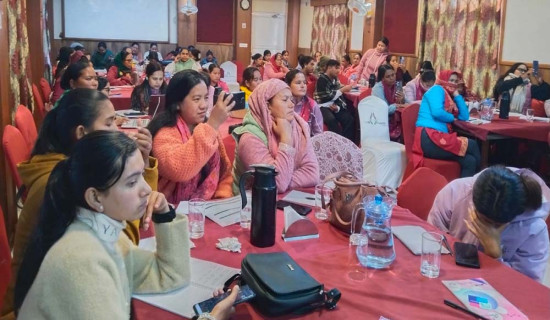- Thursday, 25 December 2025
Tackle Food Crisis
Uttam Maharjan
The world is in the grip of food insecurity. Millions of people, especially in Asia, Africa and Latin America and the Caribbean, are deprived of access to adequate food, thus balking them of the right to sufficient, safe and nutritious food. As such, they are forced to lead a miserable life instead of an active and healthy life because their dietary requirements are hardly met.
In 2020, 720 million to 811 million people faced hunger vis-à-vis in 2019, when 650 million people faced hunger. As compared to 2019, 46 million more in Africa, 57 million more in Asia and 14 million more in Latin America and the Caribbean faced hunger in 2020. As many as 660 million people may face hunger in 2030 owing partly to the effect of the COVID-19 pandemic on global food security. The projection would have been 630 million had COVID-19 not struck the world.
In 2020, the number of undernourished people was put at 768 million: 418 million in Asia, 282 million in Africa and 68 million in Latin America and the Caribbean. Nearly one in three people, or 2.37 billion people, did not have access to sufficient food in 2020, an increase of 320 million undernourished people in just one year. After remaining almost constant from 2014 to 2019, the rate of undernourishment increased to 9.9 per cent in 2020. It was 8.4 per cent in 2019.
Global prevalence
The global prevalence of moderate or severe food insecurity slowly rose from 2015 to 2019. But the increase in 2020 alone was tantamount to the figures of the last five years combined. In 2019, 3 billion people were deprived of healthy diet owing to high cost of food and income inequality. In fact, the COVID-19 was one of the factors contributing to increasing hunger in 2020.
As per the Global Report on Food Crisis of UN Food and Agriculture Organisation, the World Food Programme and the European Union, the number of people without adequate food to eat hit an all-time high in 2021. Almost 193 million people in 53 countries suffered acute food insecurity in 2021 owing to conflict, weather extremes and COVID-19. The number of people without adequate food to eat increased by 40 million in 2021. Countries such as Afghanistan, Congo, Ethiopia, Nigeria, South Sudan, Syria and Yemen are experiencing protracted conflicts. The food insecurity situation in these countries is dire.
The report has painted a bleak picture of Somalia. The African country may face one of the worst food crises in 2022 owing to drought, high food prices and continuing conflict and violence. As many as 6 million Somalis may face an acute food crunch. Further, the Ukraine war has exacerbated the food insecurity in Somalia and other African countries as they rely on Ukraine and Russia for wheat, fertilisers and other food supplies. As per the United Nations, the Ukraine war has increased food prices, threatening millions with hunger and malnourishment. The report called for increased investment in agriculture and appealed for US$ 1.5 billion worth of investment for farmers in the upcoming planting season to help stabilise and jack up food production.
Food security is related to the Sustainable Development Goals (SDGs). SDG 2 aims at achieving zero hunger by 2030. It is concerned with ending hunger, achieving food security and improved nutrition and promoting sustainable agriculture. However, as things stand, providing access to safe, nutritious and adequate food for all and extirpating all forms and manifestations of malnutrition seem to be a difficult proposition.
What with COVID-19 and what with the Ukraine war, food security is at stake now. The pandemic has disrupted food chain systems, increasing the risks of food insecurity. The already disrupted food chain systems have been aggravated by the Ukraine war. Experts have warned that the impact of the Ukraine war on global food security will be alarming. The International Fund for Agricultural Development (IFAD) is alarmed at the possibility of the Ukraine war of limiting food supplies and staple crops such as wheat, corn and sunflower oil, thus hiking food prices. When food prices go up, the poor will find it heavy going to have access to supplies of food and they will be forced to go to bed on an empty stomach.
As per the IFAD, Ukraine and Russia alone account for 12 per cent of food calories traded in the world. Egypt is the biggest buyer of wheat and imports it from Ukraine and Russia. Forty per cent of Ukraine’s wheat and corn are exported to the Middle East and Africa. Further, the European countries boycotting the trade in oil with Russia is likely to disrupt the supply chains further.
Concrete measures
It is not that the world has not made any endeavours to resolve the problem of hunger. But there are obstacles on the way. Conflict, climate change, economic slowdown and COVID-19 are the major challenges the world is grappling with to achieve the target of zero hunger.
Moreover, the prevalence of inequality has made it extremely difficult to achieve the goal. And the pandemic has played havoc with the achievement of the goal.
It is high time concrete measures were taken to tackle the problem of food insecurity, malnourishment and inequalities hindering millions of people from having access to food. Climate change, rising food prices, the degrading environment and COVID-19 will have adverse impacts on food security for some years to come. So adaptation strategies and policy responses need to be in place in order to ensure sufficient, safe and healthy food for all.
(Maharjan has been regularly writing on contemporary issues for this daily since 2000. uttam.maharjan1964@gmail.com)

















